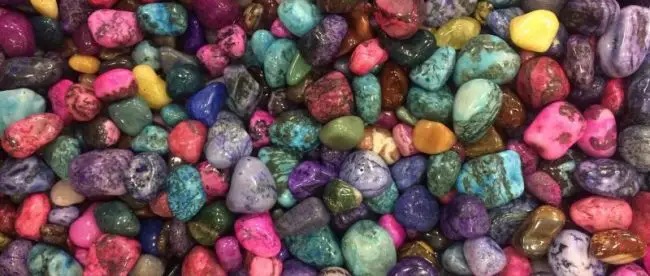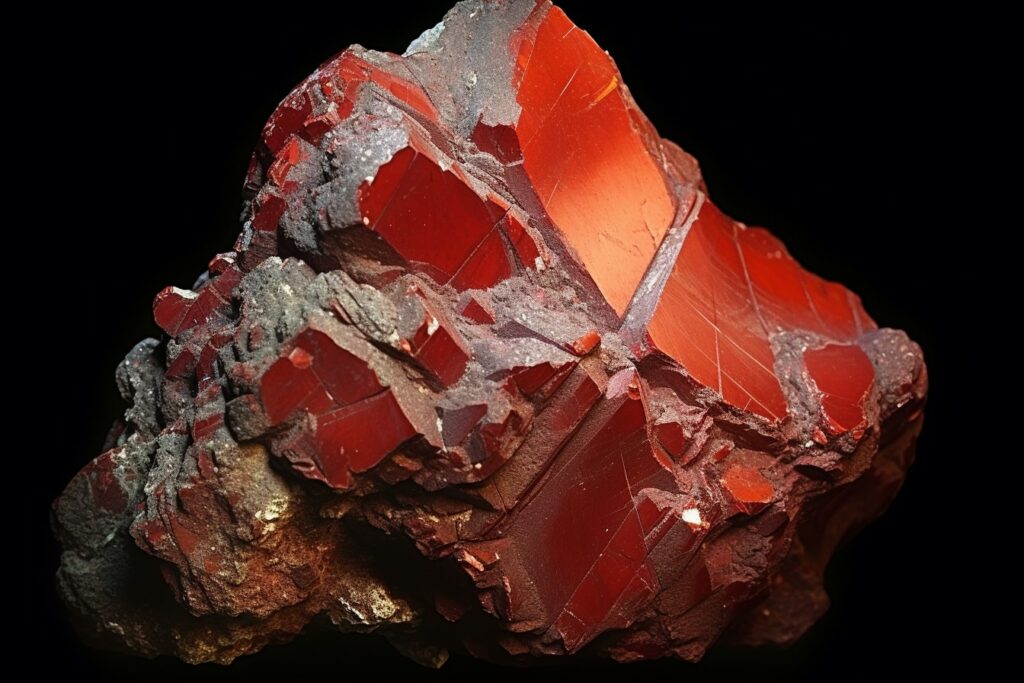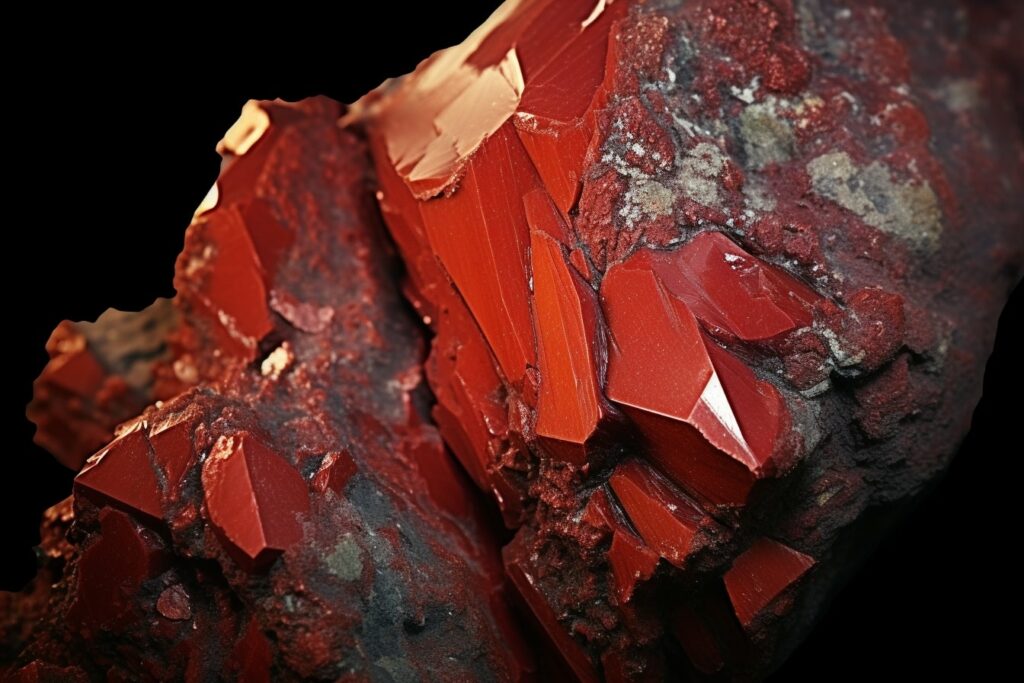Mysterious Mercury Mineral Cinnabar: Toxic & Vibrant Pigment

Cinnabar was once a popular mineral used for centuries by different cultures in jewelry, decoration, and art, due to its bright color. Known as Dragon’s blood, this popular mineral is both beautiful and thought to be dangerous.
Do you have a question about Cinnabar? Then use the table of contents below to jump to the most relevant section. And you can always go back by clicking on the black arrow in the right bottom corner of the page. Also, please note that some of the links in this article may be affiliate links. For more details, check the Disclosure section at the bottom of the page.
Here's what we'll cover:
- A Brief History of Cinnabar
- What is Cinnabar?
- What color is Cinnabar?
- Where is Cinnabar found?
- What is Cinnabar made from?
- Cinnabar in quartz
- Cinnabar and mercury
- Is Cinnabar toxic?
- Is Cinnabar Dangerous?
- Cinnabar in the Environment
- Cinnabar meaning
- Physical Properties of Cinnabar
- Cinnabar metaphysical properties
- Cinnabar healing properties
- What is Cinnabar used for?
- Cinnabar stone used in alchemy
- Proper Care of Cinnabar
A Brief History of Cinnabar
Ah, Cinnabar. Just saying the name feels like you’re tapping into ancient history, doesn’t it? And well, that’s because you kind of are. Cinnabar has been that pop of red color that humankind has swooned over for millennia. Historically, this mineral composed of mercury and sulfur has played a significant role in creating stunning red pigments, especially popular in ancient cultures. From the bands of color on pottery to detailed artistry, Cinnabar was the go-to choice for vibrant reds. Though, while it made its mark almost every place where art met aspiration, it was more than just a pretty face. In the U.S, Cinnabar was recognized as an important ore for the extraction of mercury. Common uses of Cinnabar spanned across various industries, showing its versatility and importance.
What is Cinnabar?
Cinnabar is a toxic mercury sulfide mineral that is generally found in veins in various parts of the world. It is prized for its mercury content as well as its bright color. Cinnabar may be opaque, transparent, or translucent.
Cinnabar is typically found in large mineral chunks, but rarer versions are found as Adamantine crystals. It is generally found a vein filling mineral in places where there has been volcanic activity or alkaline hot springs. It has a MOHS scale of hardness of 2-2 ½
What color is Cinnabar?
Cinnabar’s color comes in various shades of red, brownish-red, or gray. The bright red or purplish-red color is the most beautiful and the most sought after. A form of Cinnabar also comes in black.
Where is Cinnabar found?
Cinnabar usually forms in rocks surrounding recently active volcanoes but can be formed near hot springs and fumaroles. Specific places where Cinnabar can be found are Serbia, Spain, China, Italy, Greece, Turkey, South America. As well as in the US, in states of California, Texas, Oregon, and Arkansas.
Currently, China is mining large amounts of Cinnabar.
What is Cinnabar made from?
Cinnabar is a form of Mercury Sulfur known as Mercuric sulfide Hgs. It may also contain impurities of other minerals. It is a hypothermal mineral that is made from hot water and vapors as they move through fractured rock. It forms at shallow depths.
Cinnabar in quartz
Cinnabar and quartz shares the same symmetry class but have two different crystal habits. Cinnabar may be found alongside or mixed in with quartz deposits as well as embedded in quartz. When embedded in tumbled quartz, the Cinnabar appear as red spots or streaks often resembling blood.
Cinnabar and mercury
cinnabar is the only naturally occurring form of mercury. In fact, mercury is drawn out of Cinnabar by heating the mineral and allowing the mercury to escape as a vapor, which is then captured and condensed into liquid form. Cinnabar itself may, if broken open, have a drop of liquid mercury inside the mineral.
Is Cinnabar toxic?
Cinnabar has been determined to be toxic, but there has been no real determination on how toxic this mineral may be in natural form. However, to be safe, you are advised never to wear Cinnabar as jewelry next to your skin. And you are also encouraged to wear gloves when handling Cinnabar.
You should never breathe in cinnabar dust and should be aware that breaking open Cinnabar could result in a drop of liquid mercury being exposed.
While it is unknown how much Cinnabar may affect your health, mercury itself affects the neurological, gastrointestinal, and renal systems. Poisoning can be a result of inhalation, ingestion, or absorption of the skin.
However, if you want to experience all the benefits of this super powerful (in all senses) crystal, you might want to consider having a piece. E.g., this large pendant, stored in a closed glass space.

Is Cinnabar Dangerous?
Ever heard the phrase, “There’s a price for beauty”? Well, with Cinnabar, that rings kind of true. Remember, Cinnabar is a mineral composed of mercury and sulfur. Mercury? Yep, that liquid silver stuff that we’ve all been warned about. Cinnabar, in its natural form, isn’t something you’d call ‘safe’ for a casual playdate. Prolonged exposure or misuse (like using it as a lip stain, for instance!) can lead to health issues. That’s because mercury, in various forms, can be toxic. That’s not to say Cinnabar doesn’t have its safe spaces; for example, when properly handled and respected as a specimen in a collection. But, and it’s a big but, one should always exercise caution, especially in its powdered form or when carving it.
Cinnabar in the Environment
Imagine walking into a cavity in Earth and being greeted by gleaming Cinnabar crystals; it’s the stuff geologist dreams are made of! Mother Earth has her way of stashing her treasures, and Cinnabar, with its vibrant hue, is no exception. You’ll commonly find it in regions where there’s recent volcanic activity or alkaline hot springs. U.S states like California and Nevada proudly list Cinnabar in their mineral directory, with places like the New Idria district being particularly noteworthy. Internationally too, Cinnabar makes its radiant presence felt. But, while it adds a touch of rouge to the environment, remember it’s still the primary ore for mercury extraction. So, mining practices need to co-exist harmoniously with environmental concerns to ensure the beauty of Cinnabar remains untarnished in every sense.
Cinnabar meaning
Let’s dive into the mysterious depths of Cinnabar, shall we? Cinnabar is more than just a mineral; it’s a symbol, an essence, and a story that has been written in the annals of our Earth. Rooted in ancient cultures from Mexico to Hunan, the spiritual significance of this mineral cinnabar goes beyond its vibrant red hue. In ancient Rome and Persia, Cinnabar was associated with power, influence, and protection. The Olmec and the Egyptians believed its radiant color mirrored the vitality of life itself. Given its red lacquer-like hue, it was especially popular among the dynasties of ancient China for its symbolic representation of life and vitality. So, in essence, when you’re holding a piece of cinnabar, you’re not just holding a mineral. You’re clutching centuries of history, beliefs, and spiritual connections.
Cinnabar is considered to be a breakthrough stone. It is used by people wanting to make a revolutionary change. Since it is believed that this gem can guide you in difficult situations, aids in wealth creation, and may help you find love.
Physical Properties of Cinnabar
Observing Cinnabar closely, one can’t help but be enchanted by its luster. This mineral ore is composed of mercury and sulfur, resulting in that signature metallic red color. It’s not just about the hue, though. Cinnabar’s texture is usually massive to granular. When powdered, its true essence is evident, reminding one of red pigments historically used in various art forms. The surface of this gemstone can be carved intricately, showcasing its adaptability in the hands of skilled artisans. If you were to photograph it alongside other gemstones, you’d see it shining distinctively, its vibrancy unmatched. This mineral is often associated with places like Mount Diablo in Contra Costa and areas in California and Nevada like San Benito. One can almost always find cinnabar crystals nestled within a matrix, which further accentuates its splendor.
Cinnabar metaphysical properties
Cinnabar is believed to have strong metaphysical properties stimulating psychic transformation and the manifestation of spiritual energy. It is thought that this mineral can facilitate shapeshifting abilities.
Other metaphysical properties this mineral is thought to have is that it can stimulate dignity, vitality, and power. The stone is said to be beneficial in finance, helping merchants to increase their profits.
It is also believed to be a huge help in those doing community work. Also, it is thought that Cinnabar helps release unacknowledged negative emotions, and when placed near your bed may help you to find love.
Cinnabar healing properties
Cinnabar also is believed to contain several healing properties that can benefit holders of this mineral. It is said to help those with sexual dysfunction overcome their problem as well as aiding those who have difficulty conceiving.
Cinnabar is also thought to support medical treatments for blood disorders and can aid in treating fungal and viral infections. It may also help people who have issues with weight.
Cinnabar is said to help improve your stamina as well as help to improve the functioning of the immune system.
This gem is thought to help you overcome depressive thoughts and grief. It is said to help anyone wearing this stone to achieve mental stability and to relax when problems seem to be too pressing. Cinnabar may also be useful in the healing of skin issues such as boils, lesions, and warts.
What is Cinnabar used for?
Cinnabar has been used for a variety of uses throughout history. It was once used as a pigment for drawings and artwork referred to as vermilion red. As a pigment, it was used to color ornaments as well.
The ancient civilizations didn’t just admire Cinnabar for its beauty; they found manifold uses for it. Historically, cinnabar was mined in areas like Mexico, Hunan, and Slovenia to extract the element mercury. The vibrant red color made it a favorite colorant in ancient art, especially popular in places like Egypt and ancient Rome. The Olmec civilization paired it with turquoise, while the Persian empire used it as a staple in their art and craft.

But here’s a fun fact: in ancient dynasties, particularly in China, cinnabar was added to red lacquer, making it a prominent feature in burial artifacts. In Chinese and Ayurvedic cultures, Cinnabar was used as medicine as well as ingested in rituals. Cinnabar was also used in make-up when crushed into a powder.
The phrase “red as cinnabar” became synonymous with love and passion. Also, in regions like New Idria, California and Nevada, Slovakia, Ukraine, and Kyrgyzstan, it was widely used as an imitation for more expensive gemstones. While synthetic versions have been introduced in modern times, nothing quite matches the aura of the original specimen.
Cinnabar stone used in alchemy
Alchemy is the forerunner of chemistry and appears to be a combination of science and magic. Alchemists believed in the transformation of matter. The cinnabar stone has been used in Mayan cultures as protection around tombs to protect from robbers.
The mercury from Cinnabar is used to draw gold out of rocks, used in medicines, and crushed into powders for several other uses. It was also used in making medicines.
Proper Care of Cinnabar
Please note, my spiritual seekers, that due to its mercury content, cinnabar needs some tender, loving care. Keep it out of direct sunlight and avoid contact with harsh chemicals. If you have a specimen in your collection, ensure it’s not stored in resin or against surfaces that may erode its essence. It’s essential not to ingest any powdered form or let it come in prolonged contact with the skin.
When displaying your piece, ensure it’s not in an area where it can easily be knocked over or damaged. It’s also a good idea to occasionally cleanse its energy, just like you’d do with any other gemstone. Perhaps a gentle whisper of gratitude for its historical journey and the hands that once touched it wouldn’t hurt either.
And while Cinnabar has been mined and used historically, it’s crucial to source it responsibly in today’s times. Its beauty is meant to be cherished, but not at the expense of Mother Earth. So, when adding to your collection, always choose ethically sourced specimens. After all, as with all things spiritual and precious, its essence is best felt when in harmony with everything around it.
Thanks for the blog graphics: Canva.com
Disclosure: At Buddhatooth.com we only mention the products that we’ve researched and considered worthy. But it’s important to note that we are a participant of several affiliate programs, including but not limited to VigLink and Amazon Services LLC Associates Program, an affiliate advertising program designed to provide a mean for us to earn fees by linking to Amazon.com and affiliated sites. As an Amazon Associate Buddhatooth.com earns from qualifying purchases.

